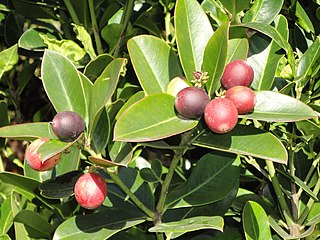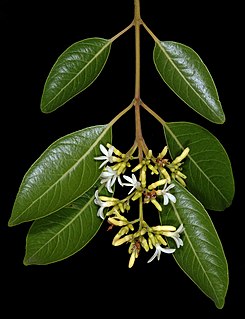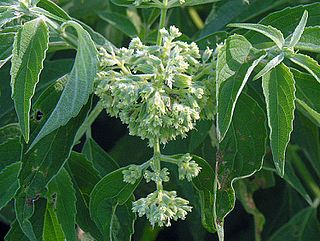
Royal Botanic Gardens, Kew is a non-departmental public body in the United Kingdom sponsored by the Department for Environment, Food and Rural Affairs. An internationally important botanical research and education institution, it employs 1,100 staff. Its board of trustees is chaired by Dame Amelia Fawcett.

Amanoa is a genus from the family Phyllanthaceae first described as a genus in 1775. It is native to South America, Central America, the West Indies, and tropical Africa.

Acokanthera oppositifolia is a shrub used as the source of an arrow poison and to coat caltrops made from the sharp fruits of the puncture vine. All plants of the genus Acokanthera contain toxic cardiac glycosides strong enough to cause death. Acokanthera oppositifolia is widespread in southern and central Africa from Cape Province north to Zaire + Tanzania.

Clutia is a plant genus of the family Peraceae. It is native to sub-Saharan Africa and to the Arabian Peninsula.
Hyaenanche globosa is a species of plant under the family Picrodendraceae. It is the sole member of the genus Hyaenanche and the subtribe Hyaenanchinae. It is endemic to Cape Province in South Africa.

Bridelia is a plant genus of the family Phyllanthaceae first described as a genus in 1806. It is widespread across Africa, Australia, southern Asia, and various islands of the Indian and Pacific Oceans.
Pseudolachnostylis is a genus of plants in the family Phyllanthaceae first described as a genus in 1899. It contains only one known species, Pseudolachnostylis maprouneifolia native to central and southern Africa. Its common name is kudu berry, though the term also applies for Cassine aethiopica.
Heywoodia is a genus of plants in the Phyllanthaceae first described as a genus in 1907. It contains only one known species, Heywoodia lucens, native to eastern, southeastern, and southern Africa.

Vitellariopsis is a group of plants in the family Sapotaceae described as a genus in 1915. The genus is native to eastern and southern Africa.
- Vitellariopsis cuneata(Engl.) Aubrév. - Usambara Mts in Tanzania
- Vitellariopsis dispar(N.E.Br.) Aubrév. - Swaziland, KwaZulu-Natal
- Vitellariopsis ferrugineaKupicha - Zimbabwe
- Vitellariopsis kirkii(Baker) Dubard - Nampula, Tanzania, Kenya
- Vitellariopsis marginata(N.E.Br.) Aubrév. - Mozambique, Swaziland, South Africa

Callicarpa mollis is a species of beautyberry that is cultivated and grown in gardens and parks as ornamental plant. It has purple flowers. It is found in Korea and Japan.
Strelitzia caudata, commonly known as the mountain strelitzia or wild banana, is a species of banana-like Strelitzia from Africa from the Chimanimani Mountains of Zimbabwe south to Mozambique, the Northern Provinces of South Africa and Eswatini (Swaziland). It was first described in 1946 by Robert Allen Dyer in Flowering Plants of Africa, Volume 25, Plate 997. The specific epithet caudata means chopped, this refers to an appendage of a sepal, which occurs only in this species. It is one of three large banana-like Strelitzia species, all of which are native to southern Africa, the other two being S. alba and S. nicolai.

Holarrhena pubescens is a species of flowering plant in the family Apocynaceae. It is native to central and southern Africa, the Indian Subcontinent, Indochina, and parts of China. In Cambodia, it is called /tɨk dɑh kʰlaː thɔm/ ទឹកដោះខ្លាធំ big tiger milk or /kʰlaɛɲ kŭəŋ/ ខ្លែងគង់ invulnerable kite.

Bridelia micrantha, the mitzeeri or the coastal golden-leaf, is a tree in the family Phyllanthaceae and is native to tropical and southern Africa as well as to the island of Réunion in the Indian Ocean.

Euclea racemosa is a small to medium-sized evergreen tree that is indigenous to the Indian Ocean coast of Africa from Egypt to South Africa, as well as in Comoros, Oman and Yemen.
Bridelia tenuifolia is a tree in the family Phyllanthaceae. It is native to southern Africa.
Bridelia speciosa is a tree in the family Phyllanthaceae native to tropical western Africa.

Bridelia retusa is a species of Bridelia found in Bangladesh, Nepal, India, Sri Lanka, southern China, Indochina, Thailand and Sumatra.

Diplorhynchus is a monotypic genus of plant in the family Apocynaceae found in tropical and southern Africa. As of August 2013 the World Checklist of Selected Plant Families recognises the single species Diplorhynchus condylocarpon.

Hoslundia is a genus of flowering plant in the family Lamiaceae, first described in 1804. It contains only one known species, Hoslundia opposita. It is widespread across much of sub-Saharan Africa including Madagascar.

Vitellariopsis marginata is a species of plant in the family Sapotaceae. It is native to Mozambique, South Africa, and Swaziland.













